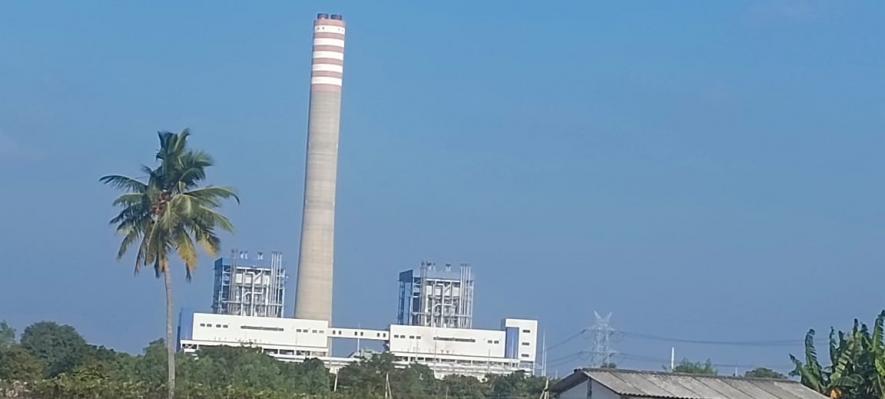Tamil Nadu Fishermen Lose 14-Year Battle to Polluting Power Plant

Fishermen and environmental activists have alleged that agricultural output and fish yield from the Bay of Bengal seacoast has declined substantially owing to the pollution caused by the power plants.
New Delhi: Fishermen in Tamil Nadu’s (TN) Cuddalore district have lost a 14-year legal battle after the Supreme Court (SC) allowed the polluting 3,600 megawatt (MW) coal-based power project of IL&FS Tamil Nadu Power Company Limited (ITPCL) to continue operating.
On February 17, a Bench comprising Justices MR Shah and CT Ravikumar ruled that since ITPCL’s two units of 600 MW each, operating since September 2015 and April 2016, “supply power to approximately 40 lakh households” and are “situated in an energy deficit state, closing the power plants/units would adversely affect the state’s power sector and “shall not be in the larger public interest”.
However, the livelihood of fishing and farming communities in more than half-a-dozen villages in the proximity of the power plants has been in doldrums ever since commercial operations began in nearly eight years ago.
It has been alleged that agricultural output and fish yield from the Bay of Bengal seacoast has declined substantially owing to the pollution caused by the power plants.
At the same time, activists working closely with local communities in Cuddalore district perceive the apex court judgement to have opened a ray of hope for environmental litigations in the future.
“The desalination plant of the project sucks in seawater through pipelines, which destroys entire populations of small fish and other marine life. Another pipeline releases hot water into the sea, which has resulted in a sharp decline in marine population in the area,” alleged M Kalaiselvam, a resident of fishing village Pudukuppam, near the project site.
“The growth of local vegetation has been stunted ever since the power plant began operating. The yield of food crops and cash crops has decreased due to air pollution caused by the plant,” he told Newsclick.
“A thick coat of dust has settled on all forms of vegetation in the region. Young children have developed lung and heart ailments due to the poor air quality,” Kalaiselvam added.
The project was conceived to meet the electricity needs of a petrochemical hub approved to be set up in the Cuddalore and Nagapattinam districts by the then-UPA government.
In June 2017, the NDA government formally notified the establishment of the Petroleum, Chemicals and Petrochemical Investment Region (PCPIR) in the two districts. Parliament was informed that the TN government had notified nearly 247 sq km for the hub, which won’t endanger the environment.
Surprisingly, around two years later, the TN government cancelled the project citing objections of local communities and on the grounds that the project site was in an environmentally fragile area and sensitive agricultural zone.
Cuddalore’s fishermen were opposed to the power project on environmental grounds ever since it was approved by the UPA government in 2010 and challenged the approval in the National Environmental Appellate Authority in the same year.
The case was transferred to the National Green Tribunal (NGT) when it was established a year later. In May 2012, the NGT upheld the validity of the project’s environmental clearance but asked the Union Ministry of Environment & Forests (the ministry as it was called under the UPA regime) to stipulate additional conditions, if any, upon ITPCL for establishing the power plant.
These conditions were to be determined on the basis of a cumulative impact assessment, as advised by the NGT, since the project was to come up near various polluting industries. The tribunal ordered for the suspension of the project’s environmental clearance till the aforementioned directions were carried out.
“The huge power project was disadvantageous for local fishing and farming communities in several ways. They lost their individual rights over land. They also lost customary rights over community lands that they had been using since several generations for various activities like drying, sorting and packaging of fish,” Cuddalore-based environmental activist T Arulselvam told Newsclick.
“Now, the forest department has also taken control of the casuarina forests on the seacoast, prohibiting entry of local communities.”
Activists and fishers allege that the government pushed through the project by sidelining interests of local communities.
“Industrial activity have caused sea erosion. Mouths of creeks in several villages that opened into the sea are blocked due to sediment deposition. The mouths of these creeks were traditionally used by fishermen to dock their boats and enter the sea. Now, they tow their boats for miles before venturing into the sea,” added Arulselvam.
The project proponent, in accordance with the NGT’s May 2012 directions, compiled a voluminous document mentioning the cumulative impact assessment but allegedly just within two weeks. Moreover, it was also alleged that the assessment was done without considering all environmental factors. The study, thereafter, came to be referred as the Rapid Cumulative Impact Assessment Study for the thermal power plant.
“The cumulative impact assessment study was lacking on several fronts. There were, at least, 30 chemical industries to the north of the proposed power plant. There are fragile mangroves less than 10 km to the south of the site,” climate and health campaigner Shweta Narayan told the Newsclick.
According to Narayan, the assessment “didn’t even consider the amount of pollution that would be caused when coal-laden ships would bring in raw material for the plant. The study did not consider the impact of the already existing operations of the public sector undertaking NLC India Limited”.
Nevertheless, the environment ministry’s Expert Appraisal Committee (EAC) recommended a corrigendum containing additional terms and conditions to be added to the environmental clearance based upon this study.
The original petitioners challenged this corrigendum in the NGT, which quashed the corrigendum in an order dated November 10, 2014.
The Principal Bench of the tribunal, headed by its the then-chairperson Justice Swatanter Kumar ordered: “ … the RCEIA [Rapid Cumulative Environment Impact Assessment] Study in question was neither adequate and in fact was erroneous nor was the application of mind done by the EAC to such study … We are, therefore, of the considered opinion that the EAC failed to apply its mind to the material placed before it by the rival parties and proceeded to recommend the conditions purportedly for safeguarding the environment.”
However, within a few months, an interim stay on the NGT order was obtained by the project proponent ITPCL in February 2015. Construction of the thermal power plants, not barred by the tribunal, was unabated. The state government also entered into a power-purchase agreement with the project proponent even as plans to set up the petrochemical hub got shelved.
The project proponent later informed the SC that the plant had been running in compliance with conditions stipulated in the environmental clearance and the corrigendum thereof. The top court was also told that the project proponent had spent around Rs 775 crore on installation of Flue Gas Desulphurisation equipment to reduce emission of sulphurous oxides. A further Rs 11,000 crore was spent, the project proponent argued, in setting up the two units of 600 MW each.
Besides, the project proponent told the court that larger public interest would be served in realising the investment and recovering the company’s debt, which was taken over by the Centre ever since IL&FS was declared bankrupt in 2019.
The SC Bench, in allowing the power plant to continue operations, ordered that the judgement “shall not be cited as a precedent in any other matter”. The Bench also made it clear that an aggrieved person may always “challenge” corrigenda issued on environmental clearances by the environment ministry.
“The ministry often issues corrigendum to existing environmental clearances. The judgement makes it clear that these corrigenda can be challenged in a court of law,” Narayan said.
“Further, nowhere have the courts objected to conducting a cumulative impact assessment for the thermal power plant. This is a bigger victory for us because industrial projects are often pushed through at the cost of environment on the grounds that the sites chosen are already polluted in nature.”
The writer is an independent journalist.
Get the latest reports & analysis with people's perspective on Protests, movements & deep analytical videos, discussions of the current affairs in your Telegram app. Subscribe to NewsClick's Telegram channel & get Real-Time updates on stories, as they get published on our website.
























